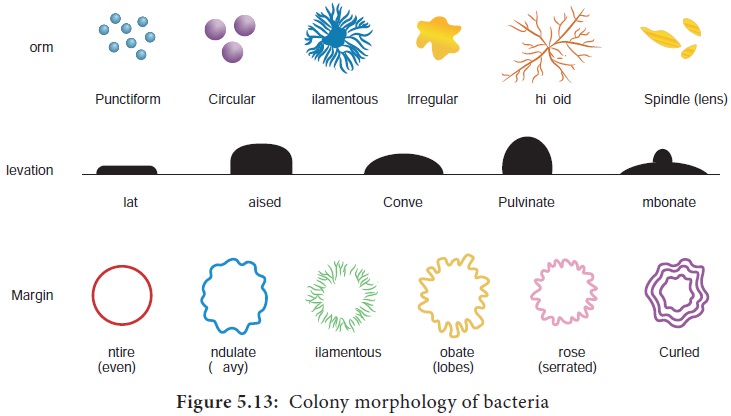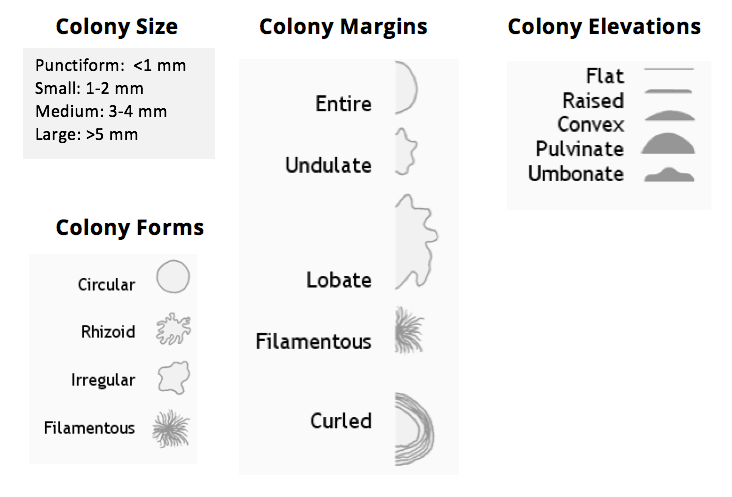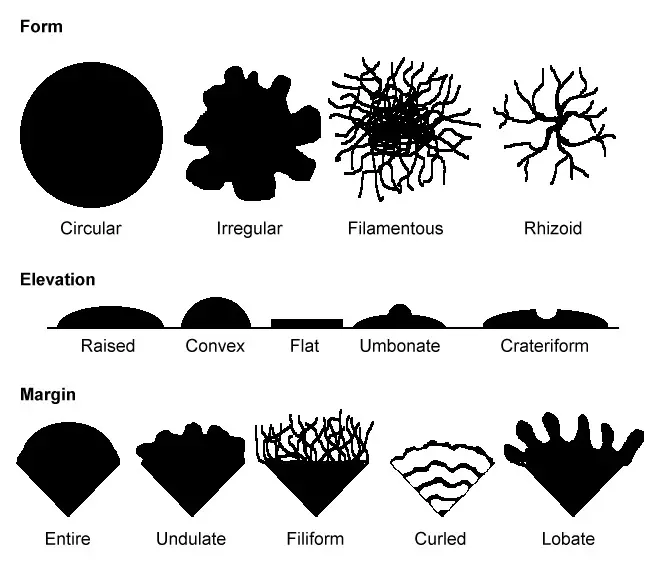Colony Characteristics Are Used to Describe
In this blog post you will find common criteria that are used to characterize the bacterial growth. Ubiquity of Bacteria View the video at the link Procedure.

Microorganisms And Their Colonial Characteristics Microbiology Class
A swab from a bin spread directly onto nutrient agar.

. Another important characteristic of a bacterial colony is hemolysis. Based on the opacity of the colony bacterial colonies are. Based on the surface of the colony it is smooth rough wrinkled glistened and dull.
This is called an entire margin if the colony has a clean edge that covers the whole colony. Hemolysis is the result o f the lysis of the blood cells that are a component of Blood Agar. Click on this link for colony morphologyNote the terminology that is used to describe Shape Margin and Elevation of the colonies on this TSA plate.
Elevation This describes the side view of a colony. Form The form refers to the shape of the colony. These forms represent the most common colony shapes you are likely.
Measurement of the colonies dimensions. Colony morphology is a method that scientists use to describe the characteristics of an individual colony of bacteria growing on agar in a Petri dish. Shape otherwise known as form look at the overall shape of the colony from the top.
To learn to describe bacterial growth by observation of colony characteristics. For example Staphylococcus aureus often shows up as perfectly circular colonies on an agar plate. However colony morphology is not a reliable way to identify bacteria as many different types of bacteria have similar colony morphology.
Characteristics of a colony such a shape margin elevation and pigmentation Contaminant An unwanted organism which has been accidentally introduced into a culture. Because colony morphology may be influenced by the conditions under which the species is. What color does the gram stain turn gram positives.
The term colony morphology refers to the visible characteristics of a colony. There are no clear. A colony arises from a cluster of bacterial cells growing on the surface of a solid medium.
Is it circular irregular rhizoid or some other shape. Colonies are described as to such properties as size shape texture elevation pigmentation effect on growth medium. A swab from a bin spread directly onto nutrient agar.
Colony margin this refers to the colonys edges. It can be used to help to identify them. What are the 7 basic colony morphological characteristics.
All of the following characteristics are used to describe bacterial colony characteristics EXCEPT. Then click on this link Results and Examples to view colony characteristics. When recording colony morphology it is important to also record color optical properties translucence sheen and texture moist mucoid or dry.
The color of some bacteria create pigment when they grow in an environment. Colonies need to be well isolated from other colonies to observe the characteristic shape size color surface appearance and texture. Describing Colony Morphology 1.
Different types of fungi will produce different-looking colonies some colonies may be coloured some colonies are circular in shape and others are irregular. Another way to describe colony morphology is elevation is defined as the shape displayed by a colony when observed from the side. Irregular colonies that spread rapidly over a plate should be identified as spreading in addition to.
The genetic makeup of the bacteria and its environment nutrients temperature and incubation time. From the aquatic systems below where are heterotrophic Bacteria the most abundant. Colony morphology is a method that scientists use to describe the characteristics of an individual colony of bacteria growing on agar in a Petri dish.
This refers to the overall shape of the colony such as circular irregular filamentous and so on. It includes form elevation and margin of the bacterial colony. Colonies that differ in appearance are typically different bacterial strains species or genera.
The appearance of the colony can be used to identify bacteria as different bacteria produce different-looking. These are the most common. However remember that color is.
Ubiquity of Bacteria and Culture Media Preparation-Virtual Labs Exercise 2. Margin The margin or edge of a colony or any growth may be an important. One example of this is Pseudomonas.
Cooling size shape margin surface elevation texture and optical properties. Characteristics of a colony such as shape edge elevation color and texture. Colonies differ in their shape size colour and texture.
A specific terminology is used to. Next describe colony morphology by noting down the following characteristics. Surface refers to how the colonys surfaces such as smooth rough shiny dull or wrinkled.
It can be used to help to identify them.

Growth And Colony Characteristics Of Bacteria And Fungi

Bacteriological Culture Methods Microbiology A Laboratory Experience

No comments for "Colony Characteristics Are Used to Describe"
Post a Comment